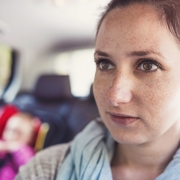Traveling with your child with autism
Planning a trip with your child who has autism? Whether it’s a long car ride to a vacation destination or a short road trip, preparation is key to making the journey as smooth and enjoyable as possible. For some children with autism, car rides offer a comforting sense of routine. They may enjoy looking out the window at the passing scenery, listening to music, or even napping during the drive. Others, however, may find the experience challenging—leading to restlessness, anxiety, or disruptive behaviors like crying, kicking seats, or attempts to unbuckle seat belts.
No matter where your child falls on this spectrum, the strategies shared in this guide can help you navigate the journey with greater ease and create a more pleasant experience for the entire family. With thoughtful planning and a few simple techniques, your next car trip can be filled with positive memories rather than stress.

Preparation before traveling with your child with autism
We all prepare in some fashion before taking a trip and it is no different when traveling with your child with autism. The unknown can be scary. Prepare your child for the trip.
What to discuss with your child with autism before the road trip
- Talk with your child about the purpose of the trip.
- Talk about where you are going. You might create social stories to present this information more clearly with visuals. Remember, any type of visual support will reduce anxiety and increase interest.
- How long it will take, and the stops along the way. Use schedules, maps, and even photo albums to help understand where you are going and whom you will see.
- Make it clear why you’re taking this trip together.
Keep it positive as something to look forward to. Prepare a snack bag as well as a toy bag ahead of time so you have food when your child is hungry and toys when your child is bored. Toys such as drawing boards, electronics (iPad or similar device) on which the child can play games or watch movies, travel games such as Perfection, and books may work well to keep your child occupied.
What to bring on the trip
- Hand sanitizer
- Flushable wipes
- Extra batteries and chargers
- Changes of clothing in case of accidents
- Plastic bags
- Medicine for nausea or other physical ailments
- Extra headphones
Traveling with your child with autism: Essential Safety Tips
Ensuring a safe and comfortable journey when traveling with a child with autism starts with thoughtful preparation.
Secure the Car Environment:
Before setting off, engage the child lock feature to prevent rear doors from being opened from the inside. Additionally, if your child tends to unbuckle their seatbelt, consider investing in seatbelt covers or buckle guards to discourage tampering.
Optimize the Car Seat Setup:
Ensure the child’s car seat is installed correctly and securely fastened according to manufacturer guidelines. For extra comfort during long rides, add soft padding beneath the seat cover to help reduce pressure and improve support. This small adjustment can make a significant difference in your child’s experience.
Sensory-Friendly Preparations:
Consider bringing along comfort items such as noise-canceling headphones, favorite toys, or fidget tools to help manage sensory sensitivities. Calming music or familiar playlists can also create a soothing environment.
By taking these proactive steps, you’ll not only enhance your child’s safety but also make the journey more enjoyable for everyone involved.
Strategies to use throughout traveling with your child with autism
Be Realistic and Flexible:
Long car trips can be challenging, so anticipate the need for regular breaks. Watch for signs of anxiety, such as restlessness or changes in body language, and take pit stops as needed. Allow your child time to stretch, run around, or simply reset. Splitting the trip into manageable segments—even turning it into a scenic mini-vacation with fun stops along the way—can make the journey far more enjoyable for everyone.
Plan Mileage and Reward Systems:
Breaking your route into smaller chunks is a helpful strategy to reduce stress. If your total drive is 300 miles, for instance, divide it into segments of 30 miles or less, depending on your child’s tolerance. Create a reward system: for every successful segment (defined by criteria you set, such as sitting nicely or refraining from disruptive behaviors), let your child pick a prize from a pre-prepared reward bag filled with treats, small toys, or favorite items.
Minimize Uncertainty:
Children with autism often thrive on predictability. Help your child visualize progress by drawing squares or markers on a piece of paper, representing each completed segment of the trip. Consider making the halfway point a special reward milestone to keep motivation high.
Stay Calm and Present:
Trying to rush through the trip can heighten stress levels and increase the likelihood of forgetting essentials. Instead, take deep breaths, relax, and use calming techniques like playing soft music to keep yourself grounded—even when traffic becomes frustrating.
How LeafWing Center Can Help
Traveling with a child with autism doesn’t have to be overwhelming. LeafWing Center offers personalized strategies and parent coaching to prepare your child for new environments and situations, such as long road trips. Through behavior therapy and social readiness training, your child can learn coping mechanisms for managing anxiety and sensory sensitivities during travel. The team at LeafWing Center can also assist in developing tailored reward systems that encourage positive behavior throughout the trip.
By preparing thoughtfully and leveraging expert support from LeafWing Center, you can transform your road trip into a successful and enjoyable experience for the entire family.
Bon Voyage and happy travels!
Glossary Terms
Other Related Articles:
- Social Stories and Autism
- Smooth Skies Ahead: A Parent’s Guide to Air Travel with Children with Autism
- Autism And Motivation In Children
- What Approach Should Caregivers Take with Challenging Behaviors?
- What Not To Do With A Child With Autism
Frequently asked questions about ABA therapy
What is ABA Therapy used for?
ABA-based therapy can be used in a multitude of areas. Currently, these interventions are used primarily with individuals living with ASD; however, their applications can be used with individuals living with pervasive developmental disorders as well as other disorders. For ASD, it can be used in effectively teaching specific skills that may not be in a child’s repertoire of skills to help him/her function better in their environment whether that be at home, school, or out in the community. In conjunction with skill acquisition programs, ABA-based interventions can also be used in addressing behavioral excesses (e.g., tantrum behaviors, aggressive behaviors, self-injurious behaviors). Lastly, it can also be utilized in parent/caregiver training.
In skill acquisition programs, a child’s repertoire of skills is assessed in the beginning phase of the services in key adaptive areas such as communication/language, self-help, social skills, and motor skills as well. Once skills to be taught are identified, a goal for each skill is developed and then addressed/taught by using ABA-based techniques to teach those important skills. Ultimately, an ABA-based therapy will facilitate a degree of maintenance (i.e., the child can still perform the learned behaviors in the absence of training/intervention over time) and generalization (i.e., the learned behaviors are observed to occur in situations different from the instructional setting). These two concepts are very important in any ABA-based intervention.
In behavior management, the challenging behaviors are assessed for their function in the beginning phase of the services. In this phase, the “why does this behavior happen in the first place?” is determined. Once known, an ABA-based therapy will be developed to not just decrease the occurrence of the behavior being addressed, but also teach the child a functionally-equivalent behavior that is socially-appropriate. For example, if a child resorts to tantrum behaviors when she is told she cannot have a specific item, she may be taught to accept an alternative or find an alternative for herself. Of course, we can only do this up to a certain point—the offering of alternatives. There comes a point when a ‘no’ means ‘no’ so the tantrum behavior will be left to run its course (i.e., to continue until it ceases). This is never easy and will take some time for parents/caregivers to get used to, but research has shown that over time and consistent application of an ABA-based behavior management program, the challenging behavior will get better.
In parent training, individuals that provide care for a child may receive customized “curriculum” that best fit their situation. A typical area covered in parent training is teaching responsible adults pertinent ABA-based concepts to help adults understand the rationale behind interventions that are being used in their child’s ABA-based services. Another area covered in parent training is teaching adults specific skill acquisition programs and/or behavior management programs that they will implement during family time. Other areas covered in parent training may be data collection, how to facilitate maintenance, how to facilitate generalization of learned skills to name a few.
There is no “one format” that will fit all children and their families’ needs. The ABA professionals you’re currently working with, with your participation, will develop an ABA-based treatment package that will best fit your child’s and your family’s needs. For more information regarding this topic, we encourage you to speak with your BCBA or reach out to us at info@leafwingcenter.org.
Who Can Benefit From ABA Therapy?
There is a common misconception that the principles of ABA are specific to Autism. This is not the case. The principles and methods of ABA are scientifically backed and can be applied to any individual. With that said, the U.S. Surgeon General and the American Psychological Association consider ABA to be an evidence based practice. Forty years of extensive literature have documented ABA therapy as an effective and successful practice to reduce problem behavior and increase skills for individuals with intellectual disabilities and Autism Spectrum Disorders (ASD). Children, teenagers, and adults with ASD can benefit from ABA therapy. Especially when started early, ABA therapy can benefit individuals by targeting challenging behaviors, attention skills, play skills, communication, motor, social, and other skills. Individuals with other developmental challenges such as ADHD or intellectual disability can benefit from ABA therapy as well. While early intervention has been demonstrated to lead to more significant treatment outcomes, there is no specific age at which ABA therapy ceases to be helpful.
Additionally, parents and caregivers of individuals living with ASD can also benefit from the principles of ABA. Depending on the needs of your loved one, the use of specified ABA techniques in addition to 1:1 services, may help produce more desirable treatment outcomes. The term “caregiver training” is common in ABA services and refers to the individualized instruction that a BCBA or ABA Supervisor provides to parents and caregivers. This typically involves a combination of individualized ABA techniques and methods parents and caregivers can use outside of 1:1 sessions to facilitate ongoing progress in specified areas.
ABA therapy can help people living with ASD, intellectual disability, and other developmental challenges achieve their goals and live higher quality lives.
What does ABA Therapy look like?
Agencies that provide ABA-based services in the home-setting are more likely to implement ABA services similarly than doing the same exact protocols or procedures. Regardless, an ABA agency under the guidance of a Board-Certified Behavior Analyst follows the same research-based theories to guide treatment that all other acceptable ABA agencies use.
ABA-based services start with a functional behavior assessment (FBA). In a nutshell, a FBA assesses why the behaviors may be happening in the first place. From there, the FBA will also determine the best way to address the difficulties using tactics that have been proven effective over time with a focus on behavioral replacement versus simple elimination of a problem behavior. The FBA will also have recommendations for other relevant skills/behaviors to be taught and parent skills that can be taught in a parent training format to name a few. From there, the intensity of the ABA-based services is determined, again, based on the clinical needs of your child. The completed FBA is then submitted to the funding source for approval.
One-on-one sessions between a behavior technician and your child will start once services are approved. The duration per session and the frequency of these sessions per week/month will all depend on how many hours your child’s ABA services have been approved for—usually, this will be the number recommended in the FBA. The sessions are used to teach identified skills/behaviors via effective teaching procedures. Another aspect of ABA-based services in the home-setting is parent training. Parent training can take many forms depending on what goals have been established during the FBA process. The number of hours dedicated for parent training is also variable and solely depends on the clinical need for it. If a 1:1 session is between a behavior technician and your child, a parent training session or appointment is between you and the case supervisor and with and without your child present, depending on the parent goal(s) identified. Parent training service’s goal is for you to be able to have ample skills/knowledge in order for you to become more effective in addressing behavioral difficulties as they occur outside of scheduled ABA sessions. Depending on the goals established, you may be required to participate in your child’s 1:1 sessions. These participations are a good way for you to practice what you have learned from the case supervisor while at the same time, having the behavior technician available to you to give you feedback as you practice on those new skills.
As mentioned in the beginning, no two ABA agencies will do the same exact thing when it comes to providing ABA services; however, good agencies will always base their practice on the same empirically-proven procedures.
How do I start ABA Therapy?
In most cases, the first item required to start ABA therapy is the individual’s autism spectrum disorder (ASD) diagnosis report. This is typically conducted by a doctor such as a psychiatrist, psychologist, or a developmental pediatrician. Most ABA therapy agencies and insurance companies will ask for a copy of this diagnosis report during the intake process as it is required to request an ABA assessment authorization from the individual’s medical insurance provider.
The second item required to start ABA therapy is a funding source. In the United States, and in cases where Medi-Cal or Medicare insurances are involved, there is a legal requirement for ABA services to be covered when there is a medical necessity (ASD diagnosis). Medi-Cal and Medicare cover all medically necessary behavioral health treatment services for beneficiaries. This typically includes children diagnosed with ASD. Since Applied Behavior Analysis is an evidence based and effective treatment for individuals with ASD, it is considered a covered treatment when medically necessary. In many cases, private insurance will also cover ABA services when medically necessary, however in these cases, it is best to speak directly with your medical insurance provider to determine the specifics of the coverage and to ensure that ABA is in fact, a covered benefit. Additionally, some families opt to pay for ABA services out-of-pocket.
The next step to starting ABA therapy is to contact an ABA provider whom you are interested in working with. Depending on your geographic location, ABA agencies exist in many cities across the United States. Your insurance carrier, local support groups, and even a thorough online search can help you find reputable and properly credentialed ABA agencies near you. Our organization, LeafWing Center, is based in southern California and is recognized for aiding people with ASD achieve their goals with the research based on applied behavior analysis.
Once you have identified the ABA provider with whom you wish to work, they should help you facilitate the next steps. These will include facilitating paperwork and authorizations with your funding source. Once the assessment process begins, a BCBA (Board Certified Behavior Analyst) or qualified Program Supervisor should get in contact with you to arrange times in which interviews with parents/caregivers and observations of your loved one can be conducted. This will help in the process of gathering important clinical information so that with your collaboration, the most effective treatment plans and goals can be established for your loved one. This process is referred to as the Functional Behavior Assessment (FBA) and is elaborated on in different blog posts on our website. With regard as to what can be expected once ABA therapy begins, please read our blog post titled: When You Start an ABA program, What Should You Reasonably Expect from Your Service Provider?








 Which children benefit the most from ABA therapy
Which children benefit the most from ABA therapy